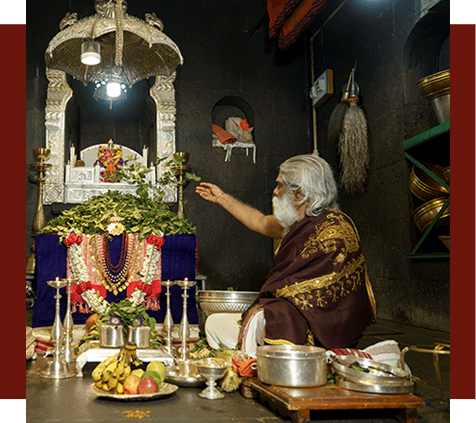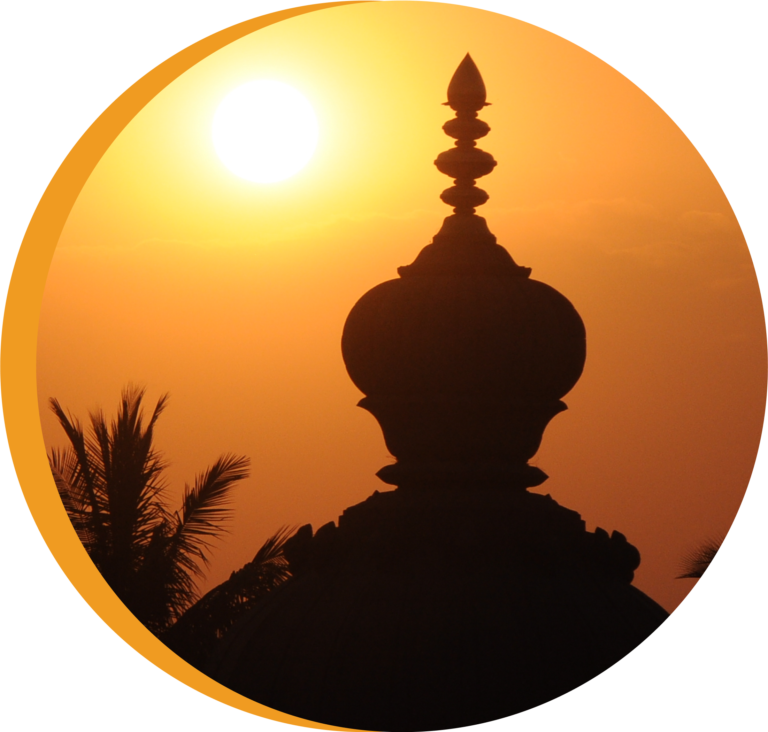
Maniknagar
Maniknagar
- How to reach
- Things to see
- Datta Jayanti
- Activities
- ebook & Downloads
Events & Festivals
Events & Festivals
No events Found. Please add Some events to your calendar.
Datta Jayanti Mahotsava
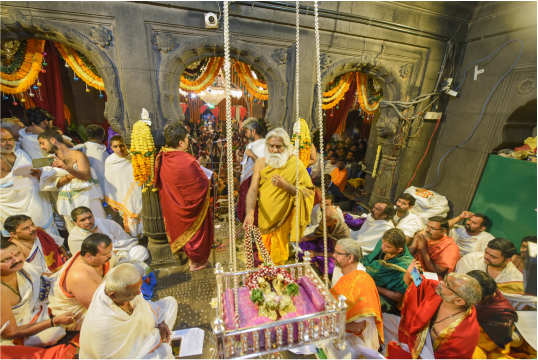
The annual Datta Jayanti Mahotsava at Maniknagar is a congregation of thousands of devotees of Shri Prabhu, cutting across geographical, linguistic, social and religious barriers, It is a religious and cultural extravaganza in which hundreds of Vedic Pundits, Musicians, Folk Artists along with lakhs and lakhs of devotees assemble at Maniknagar to pay their respects to the holy Samadhi of Shri Manik Prabhu Maharaj. It is a unique festival that promotes inter-religious harmony and showcases the socio-cultural diversity of India.
Vedant Saptah Mahotsava
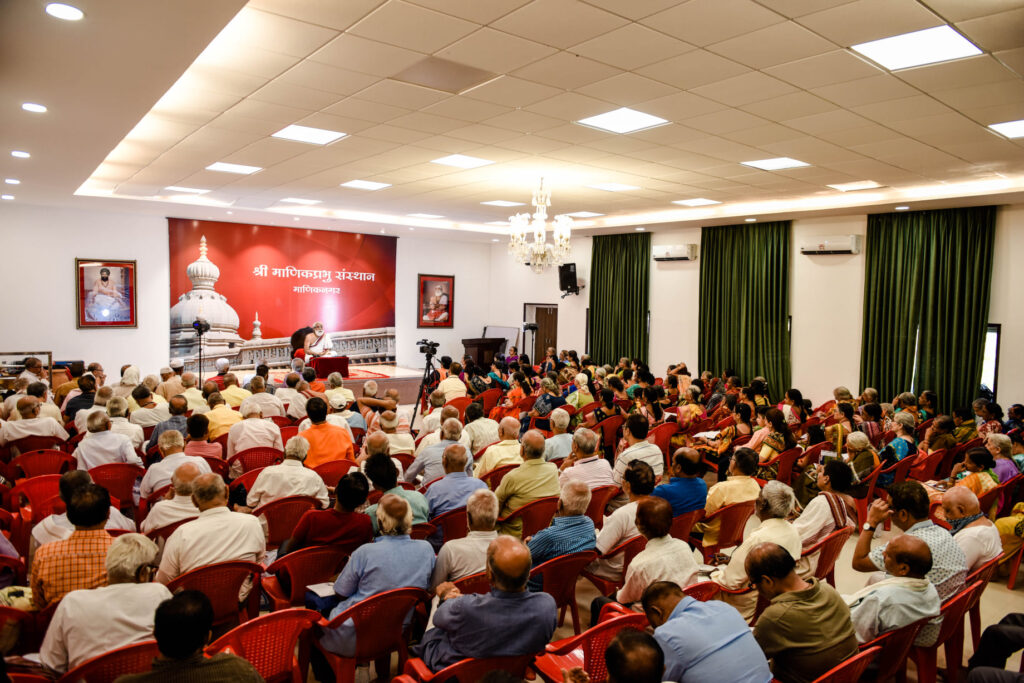
This is a week of devotional music, recitations, and philosophical discourses. It is associated with the Aaradhana of Shri Martand Manik Prabhu and Shri Shankar Manik Prabhu. The Saptaha is held in Phalgun which normally falls in the months of March – April. The evening ‘Bhajan’ led by His Holiness himself, is a special attraction of this Mahotsava. The Saptaha concludes with ‘Dindi’, a nightlong procession, in which devotees sing and dance in a state of devotional ecstasy
Shravan Maas Mahotsava
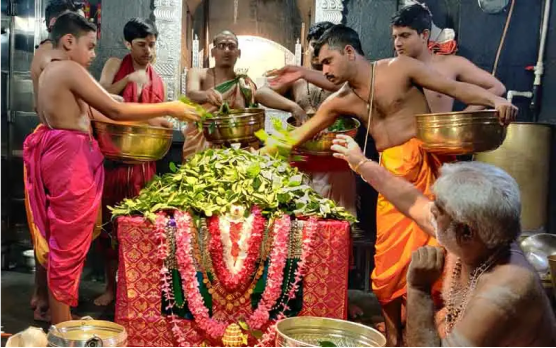
This is a month-long festival generally held between July and August every year corresponding with the Hindu lunar month of Shravan. In this month special poojas are performed at the holy Samadhi of Shri Manik Prabhu Maharaj. The Mahapooja performed every day during Shravan Maas is an elaborate ritual. The Mahapooja consists of Mahanyas, Laghunyas and Rudrabhishekam followed by Sahasra Bilwarchana, wherein 1000 leaves of the Bilwa tree are offered to Shri Prabhu with the chanting of His 1000 names Sahasranaam. This is followed by Naivedya, Aarati, and Mantrapushpam.
Thousands of devotees irrespective of caste, creed or religion are provided with free meals in the Bhandarkhana after the Mahapooja. The Mahapooja on each Monday is a very special occasion with Bhajans sung in the glory of Shri Prabhu.
The evening session is marked with a special Pradosha Pooja and Mantra Jagar chanting of the Vedas by the students of the Veda Pathashala followed by Nitya Bhajan and Aarati.
On the full moon day of Shravan popularly known as Raksha-Bandhan special religious rites are performed wherein all students of the Veda Pathashala and the temple priests together wear new Yagnyopaveetam.
On Mahasankashti special poojas are offered to Lord Ganesh with one thousand repetitions of the Ganapati Atharvasheersha. On Krishna Janmashtami Shreeji performs Krishna Janma with the singing of Bhajans at the stroke of midnight. This is followed by Mahapooja.
The 13th day of the new moon in Shravan happens to be the day on which Devi Venkamma attained Maha-Samadhi. It is said that when Shri Prabhu himself came to attend her funeral Devi Venkamma got up as if she was alive, paid her obeisance at the feet of Shri Prabhu and then again fell like a corpse. This is a very special day in the Samsthan?s calendar. Mahapooja is offered at the Samadhi of Devi Venkamma on this day.
The month-long festivities connected with Shravan Maas come to an end on the first day of Bhadrapad Maas, with a special Anna-Pooja performed by Shreeji himself.
Devi Pancharatra Mahotsava
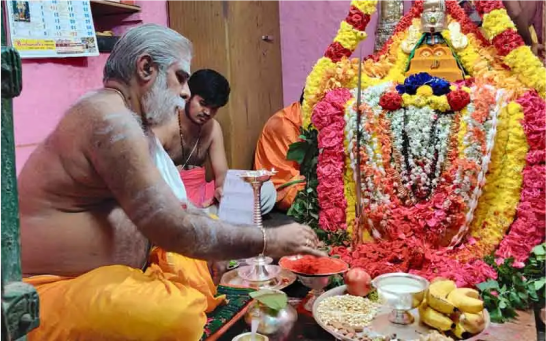
Apart from the main festivals listed above many other festivals are celebrated with great religious fervor all through the year. Not only Hindu festivals but Muslim festivals such as Gyarhavin Shareef, Moharram etc are also celebrated with equal devotion, thus strengthening mutual love and respect between the communities, which is the need of the hour. Here is a list of the important events held every year.
• Gudi Padava
• Ram navami
• Hanuman Jayanti
• Akshya Tritiya
• Punyatithi of Shri Babasaheb Maharaj
• Aashadhi Ekadashi
• Guru Pournima
• Ganesh Utsava for 11 days
• Vijaya Dashami
• Deepavali
• Kartiki Ekadashi
Guru Aaradhana Mahotsava

As per the Hindu calendar, the Punyatitithi of Shri Siddharaj Manik Prabhu Maharaj is on Ashwin Krishna Tritiya and the Punyatithi of Shri Manohar Manik Prabhu Maharaj is on Ashwin Krishna Saptami. From Tritiya to Saptami a five-day-long festival called Guru Aradhana is celebrated every year.
Manik Pournima Parva
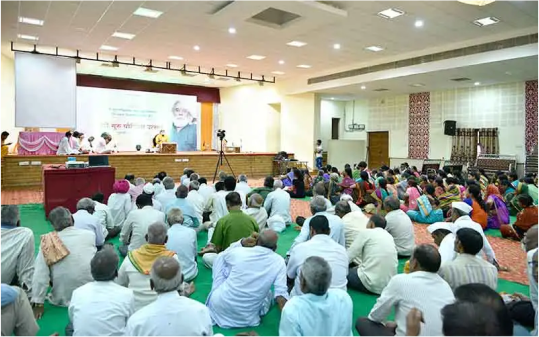
The Taittiriya Upanishad says – Swadhyay Pravachanabhyam na Pramaditavyam, meaning, one should never stray away from the process of continues self- study and listening to the Upadeshas or messages from the Guru (or the Vedas). Manik Pournima Parva is an opportunity provided to the devotees and seekers of truth to listen to the instructions of the Guru and accordingly progress on the path of spiritual development. A special interactive discourse is held on every Pournima at Maniknagar wherein Shri Maharaj Ji expounds the most difficult and complex principles of Advaita Vedanta in a very simple yet impressive manner. The discourse is followed by an interactive session between Shri Maharaj Ji and the devotees.
Other Festivals

Apart from the main festivals listed above many other festivals are celebrated with great religious fervor all through the year. Not only Hindu festivals but Muslim festivals such as Gyarhavin Shareef, Moharram etc are also celebrated with equal devotion, thus strengthening mutual love and respect between the communities, which is the need of the hour. Here is a list of the important events held every year. Gudi Padava| Ram navami| Hanuman Jayanti| Akshya Tritiya Punyatithi of Shri Babasaheb Maharaj | Aashadhi Ekadashi Guru Pournima | Ganesh Utsava for 11 days | Vijaya Dashami Deepavali | Kartiki Ekadashi.

Datta Jayanti Mahotsava
The annual Datta Jayanti Mahotsava at Maniknagar is a congregation of thousands of devotees of Shri Prabhu, cutting across geographical, linguistic, social and religious barriers, It is a religious and cultural extravaganza in which hundreds of Vedic Pundits, Musicians, Folk Artists along with lakhs and lakhs of devotees assemble at Maniknagar to pay their respects to the holy Samadhi of Shri Manik Prabhu Maharaj. It is a unique festival that promotes inter-religious harmony and showcases the socio-cultural diversity of India.
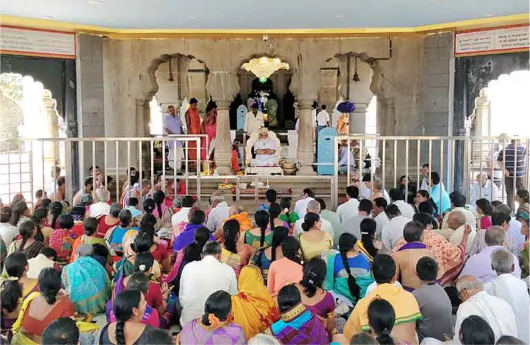
Vedant Saptah Mahotsava
This is a week of devotional music, recitations, and philosophical discourses. It is associated with the Aaradhana of Shri Martand Manik Prabhu and Shri Shankar Manik Prabhu. The Saptaha is held in Phalgun which normally falls in the months of March – April. The evening ‘Bhajan’ led by His Holiness himself, is a special attraction of this Mahotsava. The Saptaha concludes with ‘Dindi’, a nightlong procession, in which devotees sing and dance in a state of devotional ecstasy.

Shravan Maas Mahotsava
This is a month-long festival generally held between July and August every year corresponding with the Hindu lunar month of Shravan. In this month special poojas are performed at the holy Samadhi of Shri Manik Prabhu Maharaj. The Mahapooja performed every day during Shravan Maas is an elaborate ritual. The Mahapooja consists of Mahanyas, Laghunyas and Rudrabhishekam followed by Sahasra Bilwarchana, wherein 1000 leaves of the Bilwa tree are offered to Shri Prabhu with the chanting of His 1000 names Sahasranaam. This is followed by Naivedya, Aarati, and Mantrapushpam.
This is a month-long festival generally held between July and August every year corresponding with the Hindu lunar month of Shravan. In this month special poojas are performed at the holy Samadhi of Shri Manik Prabhu Maharaj. The Mahapooja performed every day during Shravan Maas is an elaborate ritual. The Mahapooja consists of Mahanyas, Laghunyas and Rudrabhishekam followed by Sahasra Bilwarchana, wherein 1000 leaves of the Bilwa tree are offered to Shri Prabhu with the chanting of His 1000 names Sahasranaam. This is followed by Naivedya, Aarati, and Mantrapushpam.
Thousands of devotees irrespective of caste, creed or religion are provided with free meals in the Bhandarkhana after the Mahapooja. The Mahapooja on each Monday is a very special occasion with Bhajans sung in the glory of Shri Prabhu.
The evening session is marked with a special Pradosha Pooja and Mantra Jagar chanting of the Vedas by the students of the Veda Pathashala followed by Nitya Bhajan and Aarati.
On the full moon day of Shravan popularly known as Raksha-Bandhan special religious rites are performed wherein all students of the Veda Pathashala and the temple priests together wear new Yagnyopaveetam.
On Mahasankashti special poojas are offered to Lord Ganesh with one thousand repetitions of the Ganapati Atharvasheersha. On Krishna Janmashtami Shreeji performs Krishna Janma with the singing of Bhajans at the stroke of midnight. This is followed by Mahapooja. The 13th day of the new moon in Shravan happens to be the day on which Devi Venkamma attained Maha-Samadhi. It is said that when Shri Prabhu himself came to attend her funeral Devi Venkamma got up as if she was alive, paid her obeisance at the feet of Shri Prabhu and then again fell like a corpse. This is a very special day in the Samsthan?s calendar. Mahapooja is offered at the Samadhi of Devi Venkamma on this day.
The month-long festivities connected with Shravan Maas come to an end on the first day of Bhadrapad Maas, with a special Anna-Pooja performed by Shreeji himself.

Devi Pancharatra Mahotsava
This is a five-day Mahotsava celebrated in the Hindu lunar month of Ashwin corresponding with September October. It is called the Devi Panchratra Mahotsava. It is held every year in the temple of Madhumati Shyamala, which is considered to be the Adi-Shakti of Lord Dattatreya. On the first day of the Utsava i.e. Lalita Panchami, Shreeji performs Punyahavachanam, Matruka Poojan, and Nandi Shraddha. Mahapooja to the Samadhi of Devi Venkamma and the Shrichakra worshipped by Shri Martand Manik Prabhu is performed with great religious fervour. Kumkumarchana with the thousand names of the Devi is also performed followed by Naivedya, Aarati and Mantra Pushpa.
In the evenings a special Pradosha Pooja followed by Kumari Poojan is performed. 9 Girls below the age of 12 are worshipped with due respect. Their feet are washed and they are offered special gifts. Bhajans are sung in the glory of the divine mother.
On the last day of the Utsava i.e. Mahanavami, a special Chandi Homa is performed by Shreeji amidst chanting of the Durga Saptashati. Bali is offered to the Devi and thus concludes the Pancharatra Mahotsava.
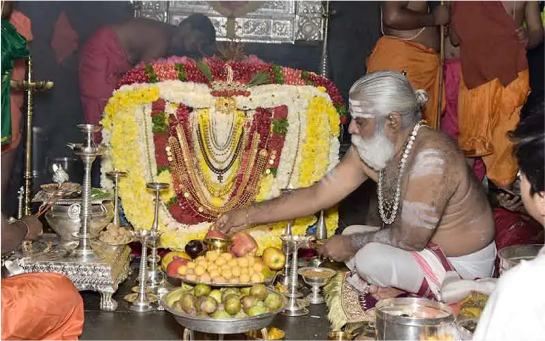
Guru Aaradhana Mahotsava
As per the Hindu calendar, the Punyatitithi of Shri Siddharaj Manik Prabhu Maharaj is on Ashwin Krishna Tritiya and the Punyatithi of Shri Manohar Manik Prabhu Maharaj is on Ashwin Krishna Saptami. From Tritiya to Saptami a five-day-long festival called Guru Aradhana is celebrated every year

Manik Pournima Parva
The Taittiriya Upanishad says – Swadhyay Pravachanabhyam na Pramaditavyam, meaning, one should never stray away from the process of continues self- study and listening to the Upadeshas or messages from the Guru (or the Vedas). Manik Pournima Parva is an opportunity provided to the devotees and seekers of truth to listen to the instructions of the Guru and accordingly progress on the path of spiritual development. A special interactive discourse is held on every Pournima at Maniknagar wherein Shri Maharaj Ji expounds the most difficult and complex principles of Advaita Vedanta in a very simple yet impressive manner. The discourse is followed by an interactive session between Shri Maharaj Ji and the devotees.

Other Festivals
Apart from the main festivals listed above many other festivals are celebrated with great religious fervor all through the year. Not only Hindu festivals but Muslim festivals such as Gyarhavin Shareef, Moharram etc are also celebrated with equal devotion, thus strengthening mutual love and respect between the communities, which is the need of the hour. Here is a list of the important events held every year.
Gudi Padava| Ram navami| Hanuman Jayanti| Akshya Tritiya Punyatithi of Shri Babasaheb Maharaj | Aashadhi Ekadashi Guru Pournima | Ganesh Utsava for 11 days | Vijaya Dashami Deepavali | Kartiki Ekadashi

© 2024 Shri Manik Prabhu Samsthan. All Rights Reserved.
Design & Developed by Pixel N Paper
